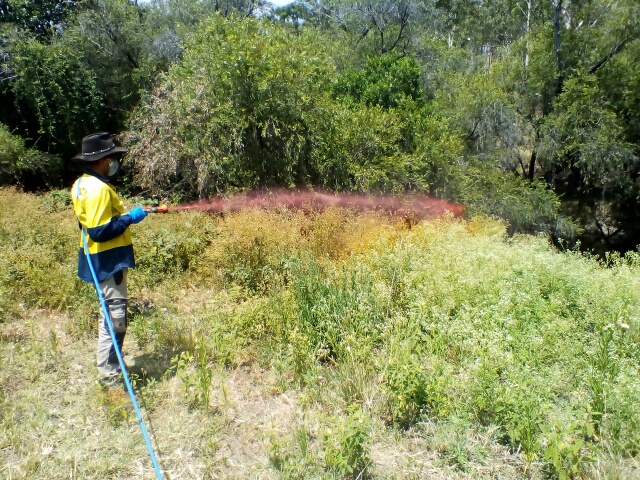BCCA’s Community Sustainability Action Grant (CSAG) —Invasive Weed Control in the Barambah and Boonara Catchments project had come to completion. The project commenced in 2018 and aimed to monitor and treat infestation levels of Rubber Vine, Parthenium Weed and Honey Locust in the Barambah, Boonara Creek and sections of the Moonda Waamba Creek located in the Gympie Regional Council (GRC) area.
This project built on previous project works which involved treatment of targeted declared plants (Rubber Vine & Parthenium) in the Barambah, Boonara and sections of the Moonda Waamba creek. Preliminary visual surveys in the GRC area, indicate that the distribution of these species was initially low due to previous control measures. Weed control work under this proposal lead to a high chance of areas becoming weed free or at a manageable level for the participating landholders.
Initial chemical treatment of the project area for Parthenium, Rubber Vine and Honey Locust was 862 hectares. The project area was found to have a higher Parthenium infestation level than initially anticipated and the contractors felt best to do a more thorough initial treatment rather than spraying less of the infestation at the outset and following up later due to the vigorous nature of the species.
Drone survey of the project area in May 2019 was conducted over 886 hectares. Rubber Vine regrowth was evident in a 100 hectare stretch of the Lower Boonara Creek. Treatment of Rubber Vine corresponded to the weed flowering, thus reducing seed pod formation which would subsequently be scattered by the wind and also carried downstream by water. Parthenium follow up treatment was carried out by contractors over a 54 hectare area on the Lower Boonara Creek which had a very high infestation of Parthenium. Continued local Council and Landholder involvement outside the grant will be required to maintain a control on the Parthenium.
The isolated infestation of Honey Locust along 3km of Ettrickdale Road along the Boonara Creek, was chemically treated in December 2018, follow up ground survey in May 2019 revealed no evidence of Honey Locust in the treatment area. Treating the Honey Locust when in flower prevented it from developing the characteristic long brown pods which are spread by grazing stock eating the pods and passing seed in dung and also spread of pods downstream via floodwaters. Overall, 70 kilometers of riverbank was remediated during the project through chemical control of Rubber Vine, Honey Locust and Parthenium.
Extension and awareness was provided to landholders in the treatment area by GRC land protection officers, landholders will have the ability to identify these invasive weeds, with early intervention to new infestations will in the long-term give the community the ability to maintain the work achieved under the CSAG.
This project was funded by the State Government acting through the Department of Environment & Science.

